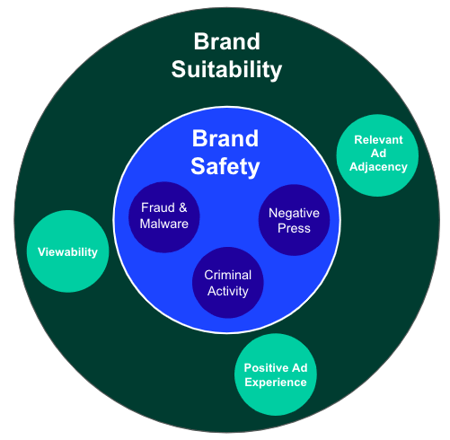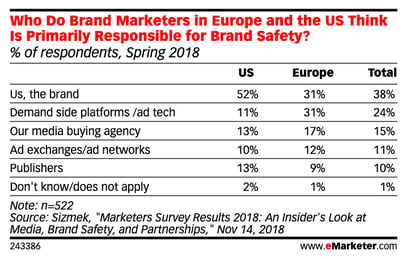Brand safety and brand suitability. These two terms are often used interchangeably, even by professionals with deep knowledge of the digital advertising ecosystem. Brand safety and brand suitability sound very similar, but in reality, they describe two different concepts. One refers to creating and refining the controls to mitigate damage to brand reputation; while the other is focused on creating parameters around positive associations with content adjacency in the user experience1.
What is brand safety?
Brand safety describes the measures a company takes to protect its brand and minimize potential risks to brand reputation when advertising online. There are two central tenets to brand safety:
- Brand safety includes ROI issues like ad fraud. If a cybercriminal can plant malware in a brand’s advertising assets, and users are defrauded, it can negatively impact the brand.
- Ad placement and context also impact brand safety. Brands appearing in ads alongside content that is illegal, dangerous, and offensive can have an impact on a brand’s reputation and revenue since many consumers view unsafe ad placement as an intentional endorsement of the negative content.
What is brand suitability?
Brand suitability builds on the fundamental concept of brand safety, extending it from avoiding negative adjacency (to inappropriate content) and moving forward to positive adjacency - identifying the placements and associations that actually build on and reinforce the brand. Brand suitability focuses on ensuring that ads are placed on pages and near content that is appropriate and suitable for the brand.
 Brand suitability requires a more complex view of where marketing assets appear, incorporating factors including audience demographics, platform, and location in addition to content proximity. Brand suitability takes brand safety to the next level: beyond ensuring that a brand’s reputation isn’t eroded by the content surrounding it. But creating positive adjacency introduces more complexity - it is more straightforward to block a negative association than create a positive one. And even that’s not easy!
Brand suitability requires a more complex view of where marketing assets appear, incorporating factors including audience demographics, platform, and location in addition to content proximity. Brand suitability takes brand safety to the next level: beyond ensuring that a brand’s reputation isn’t eroded by the content surrounding it. But creating positive adjacency introduces more complexity - it is more straightforward to block a negative association than create a positive one. And even that’s not easy!
The relationship between brand safety and brand suitability.
Why are brand safety and brand suitability important?
Brand safety is becoming a more important consideration in marketing and advertising due to several evolving factors:
- Digital advertising is taking over other marketing channels - digital ad spend is expected to top $332 billion USD in 20202, accounting for 54% of total media expenditures.
- New content is multiplying, and the opportunity for users to generate (and share) their own content is growing as well. Whether making a comment, sharing a meme, or posting a video, user-generated content is extensive, varied, and difficult to moderate.
- Gen-Z now makes up 40% of all consumers3 while also ranking as the generation most easily influenced by online advertising4.
Finally, consumers have come to expect more from brands; customer loyalty is hard to get and harder to keep. A recent study5 found that 43% of customers have stopped doing business with a company because they lost trust in the brand. According to another study6, when displayed next to generally unsafe or brand/vertical averse content:
- Consumers are nearly 3 times less willing to associate with the brand
- Consumers are half as likely to recommend a brand
- Purchase intent is cut in half
These changes to the digital world have all increased the urgency of brand safety and with it, brand suitability protections.
Brand safety and suitability challenges
There are two primary challenges to brand safety: determining who is responsible for securing brand safety and finding a content moderation solution that works.
The digital marketing ecosystem is complicated, with many different players. It can be difficult to build a consensus on who is responsible for brand safety and as a result, standards are difficult to articulate and enforce.
And the opinion of who is responsible for brand safety varies by region. In the United States, 52% of survey respondents believe that the brand itself is responsible for brand safety, with the media buying agency and digital publishers coming in next, each at 13%. In Europe, survey respondents believe brands and the demand side platforms/ad tech equally share the responsibility for brand safety; each at 31%.
Secondly, the complexity of content moderation and advertising management has made it difficult to automate the process successfully in the past. Blacklists and blocklists, which prevent materials from appearing on pages with key terms or phrases deemed ‘unsafe’, fail to account for context, language, and cultural differences that affect content safety. This has left content moderation largely to employees and user reporting, which fails to address the issue in real-time.
Recent strides have been made in using AI solutions for content moderation: particularly contextual AI - which can ‘read the room’ in terms of context, rather than just filtering for keywords.
While a complex digital ad ecosystem and diffuse responsibilities make brand safety difficult to address, brand suitability is a complex issue for marketers as well. This means that a comprehensive solution is difficult to find, and brand suitability is not currently being executed successfully by many. A recent study found that 49% of marketers had experienced a brand suitability failure; 54% had experienced hostility from customers and 44% had lost revenue as a result7.
As we move forward to better brand and user safety in the digital world, the first step is to create a common understanding of core terms, like brand safety and brand suitability. And to effectively manage brand reputation, it is important to clearly define your target: whether that is brand safety, brand suitability, or both.
The OASIS Consortium was created to advance the goals of promoting Openness, Accountability, Security, Innovation, and Sustainability across the digital world. We unite stakeholders to create actionable and measurable standards for the protection of online brand safety. Join the movement toward a better, safer internet.






